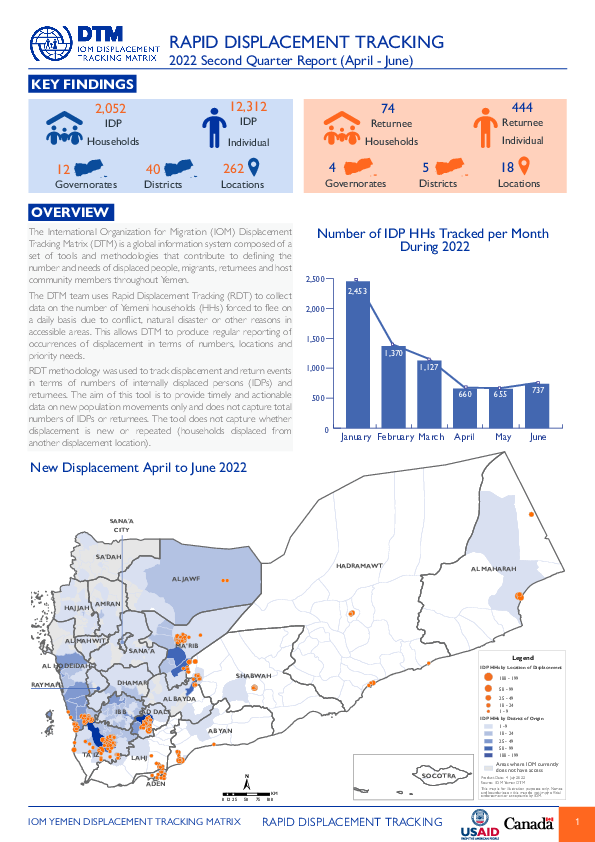-
Countries
-
Data and Analysis
-
Special Focus
-
Crisis Responses
Yemen — Rapid Displacement Tracking Update (01 April - 30 June 2022)

Contacter
DTM Yemen, iomyemendtm@iom.int
Langue
English
Emplacement
Yemen
Période couverte
Apr 01 2022
Jun 30 2022
Activité
- Mobility Tracking
During the reporting period, between 1 April to 30 June 2022, IOM Yemen DTM tracked 2,052 households (HH) (12,312 Individuals) who experienced displacement at least once compared to 4,950 households in the first quarter. This represents a decrease of 59 per cent. Since the beginning of the reporting period, the number of tracked new instances of displacement has been declining steadily due to the parties of the conflict entering a truce that began on the second day of April.
Safety and security concerns as a result of the conflict were the main reason for displacement, accounting for 79 per cent (1,618 HHs) of the total, followed by economic reasons related to conflict, accounting for 21 per cent (434 HHs).
The majority of people moved into/within the following governorates and districts:
- Marib (501 HHs) – Marib City (324 HHs), Marib (141 HHs), Harib (36 HHs) districts. Most displacements in the governorate originated from within Marib (36%) and from Al Hodeidah (12%).
- Al Hodeidah (363 HHs) – Hays (281 HHs), Al Khukhah (77 HHs), At Tuhayta (5 HHs) districts. Most displacements in the governorate originated from within Al Hodeidah (66%) and from Taiz (33%).
- Ad Dali (352 HHs) – Qatabah (195 HHs), Ad Dali (146 HHs), Al Hasayn (11 HHs) districts. Most displacements in the governorate originated from within Ad Dali (43%) and from Ibb (21%).
The majority of people moved from the following governorates and districts:
- Al Hodeidah (543 HHs) – Hays (238 HHs), Zabid (36 HHs), At Tuhayta (36 HHs) districts.
- Taiz (464 HHs) – Maqbanah (177 HHs), Al Maafer (69 HHs), Jabal Habashi (43 HHs) districts.
- Marib (253 HHs) – Al Jubah (79 HHs), Harib (71 HHs), Jabal Murad (21 HHs) districts.
Between 1 January and 30 June 2022, IOM Yemen DTM tracked 7,002 households (42,012 individuals) displaced at least once.
